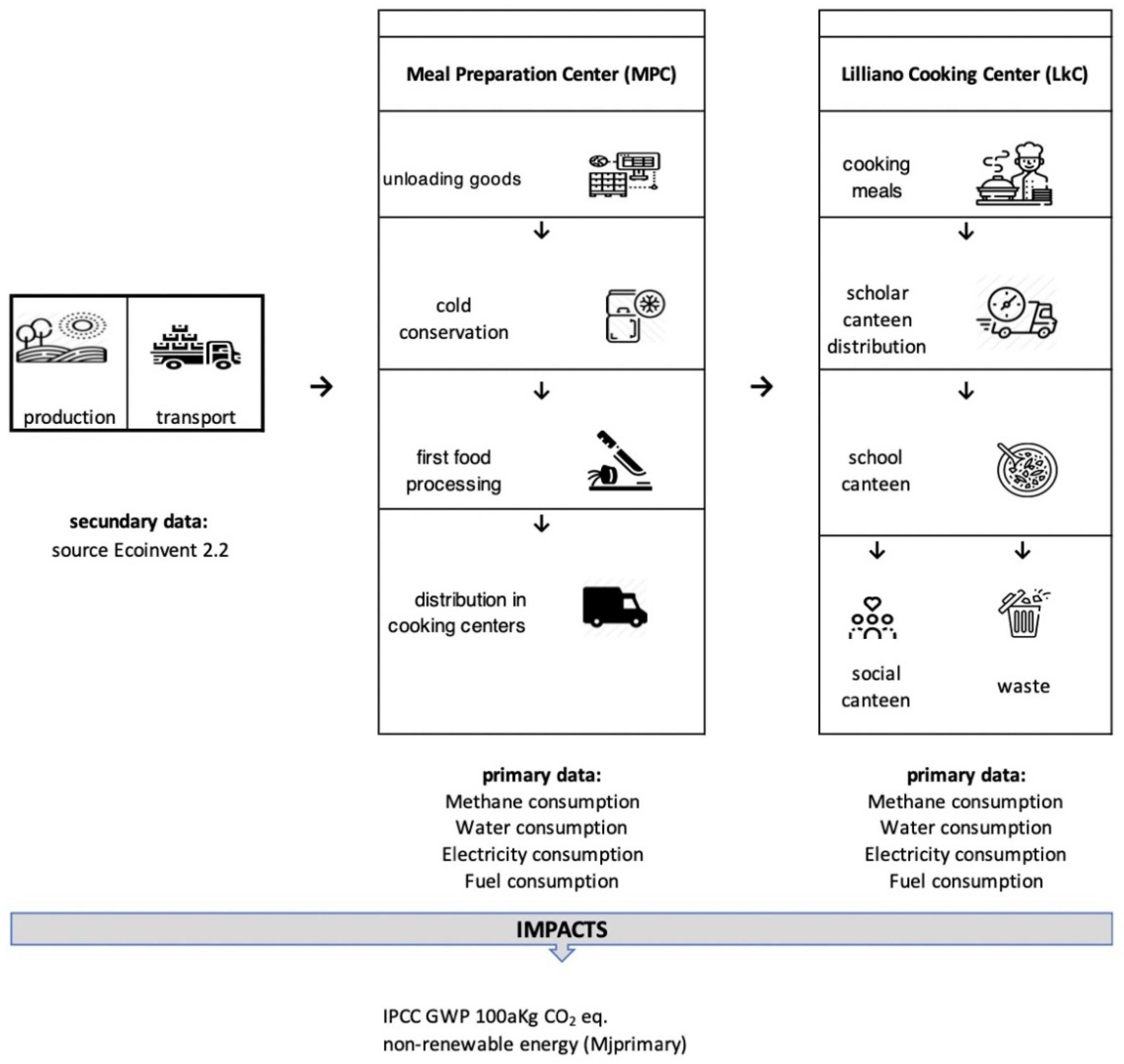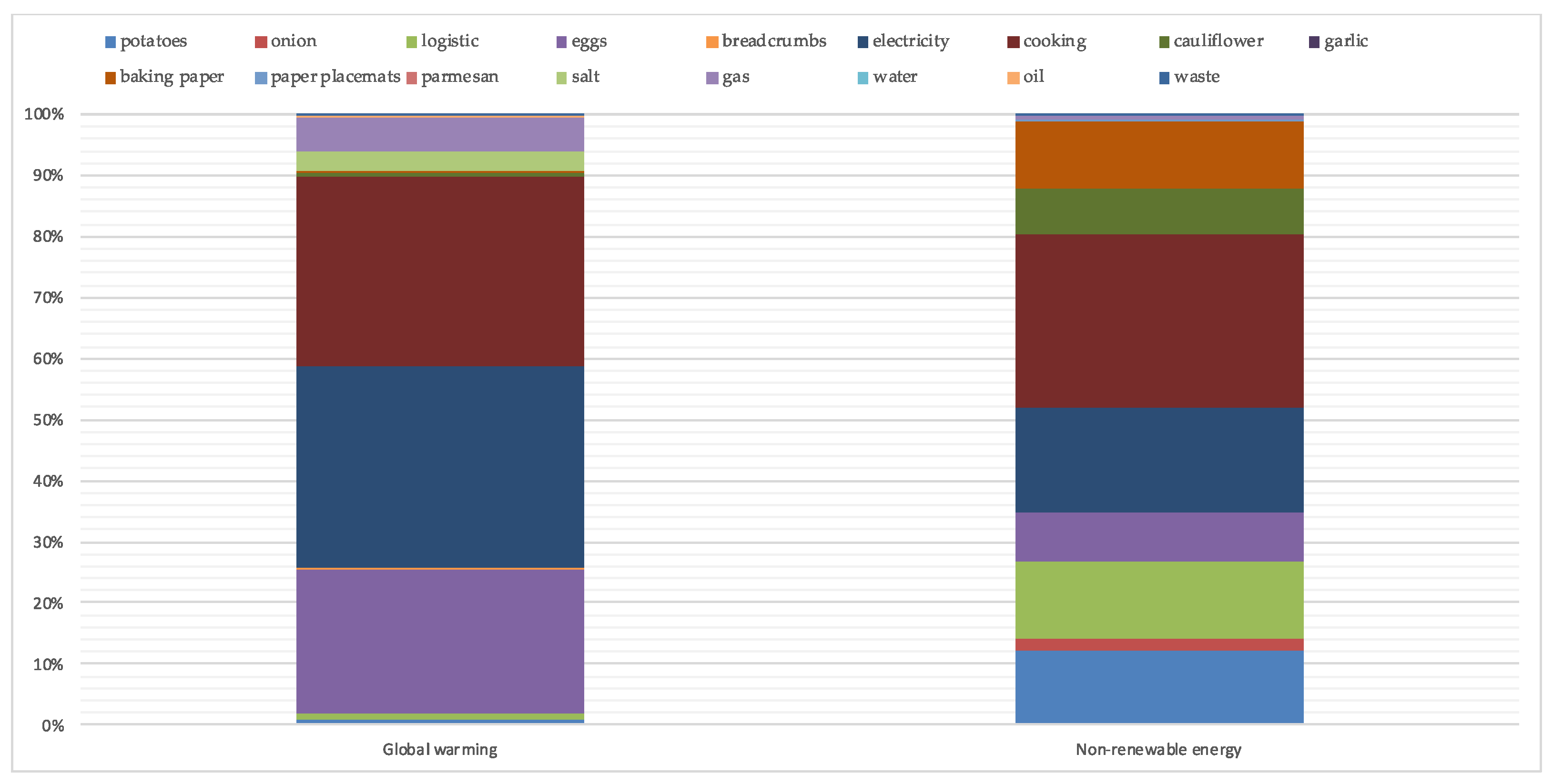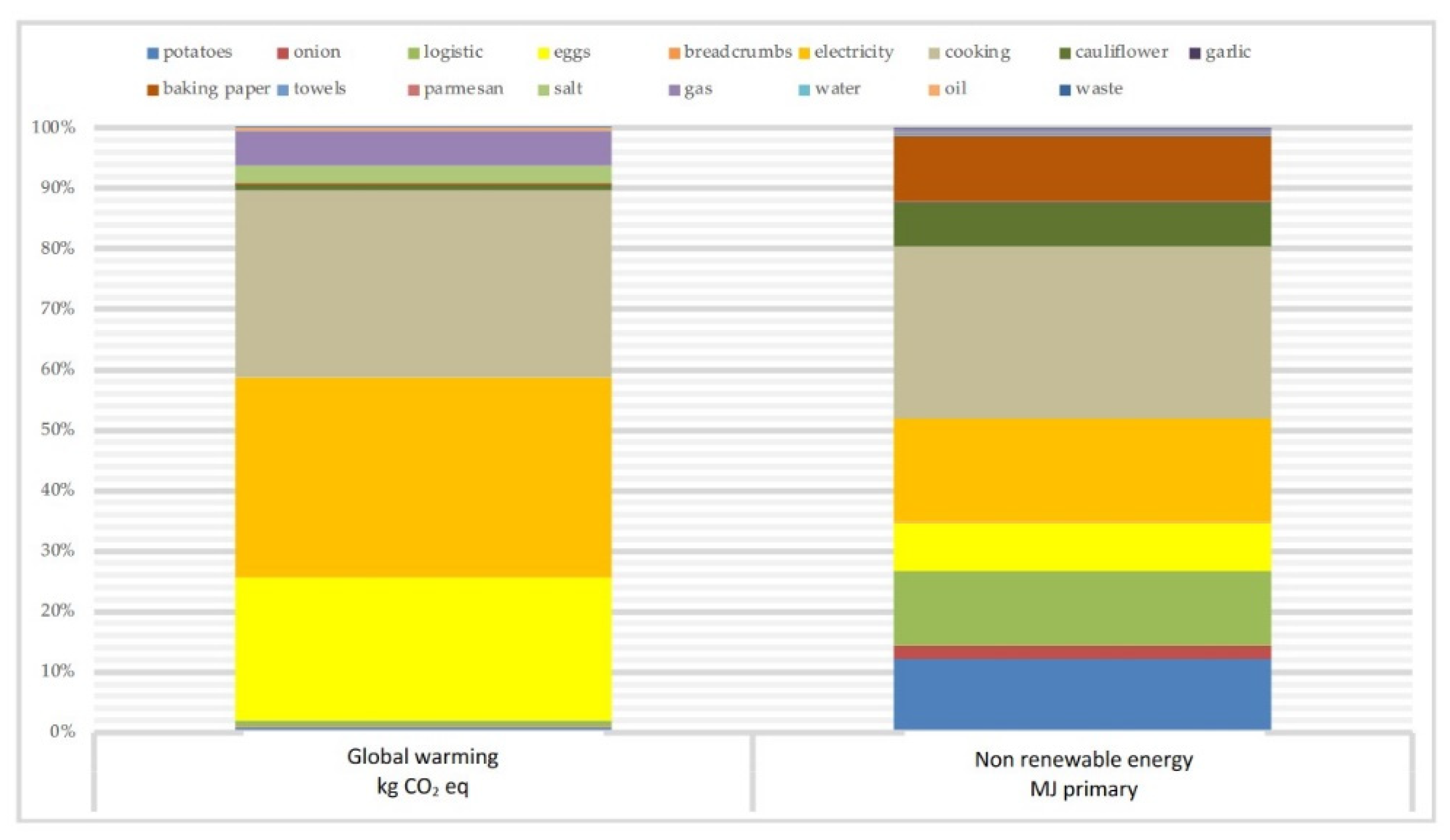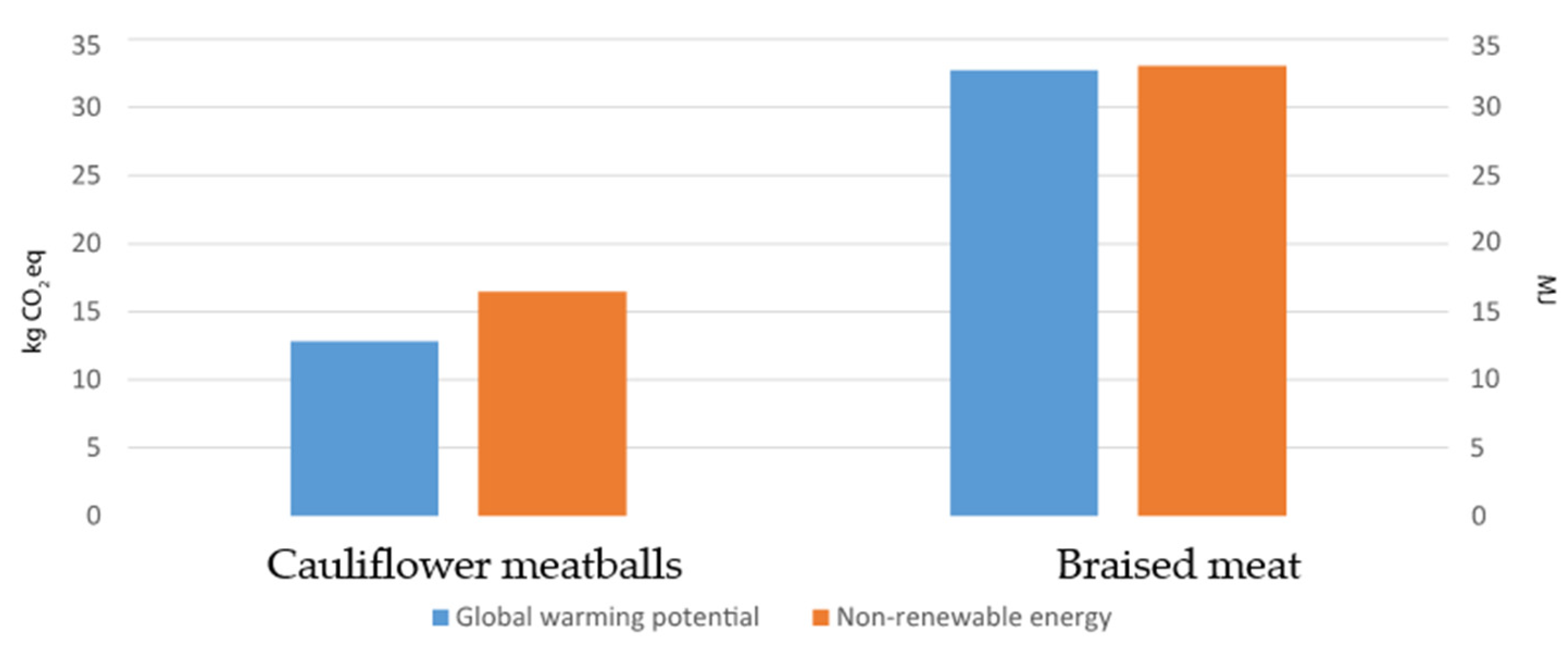Dietary Patterns at the Individual Level through a Nutritional and Environmental Approach: The Case Study of a School Canteen
Abstract
:1. Introduction
2. Case Study
3. Material and Methods
- The suppliers deliver the raw materials to the meal preparation center (MPC), located in Via Don Perosi, Bagno a Ripoli, Piemont, Italy.
- At the MPC, the products are stored, and the first preparation of the dish is carried out the day before serving it. All the phases necessary for transformation except the cooking phase, such as washing, cleaning, cutting, and preparation, are then performed.
- The semifinished dishes are transported to the Lilliano Cooking Center (LiCoCe), where the cooking and administration phase is performed at the adjacent school.
- The nonadministered inventories are cut down, packaged, and delivered to Caritas, which delivers them to needy families in the area three times per week.
- The waste is measured and then disposed through separate collection systems for recycling and municipal waste.
- Global warming potential (GWP): Evaluated global warming, obtained by considering among the substances emitted into the air those that contribute to global warming. The mass quantity of each gas was multiplied by a weight factor (different depending on the impact of the single emission and the time frame considered), thus converting all emissions into equivalent kg of CO2 as reported by Batlle-Bayer et al. [32].
- Nonrenewable energy (NRE): The primary potential energy contained in the raw materials used was considered. Once used, NRE cannot be restored for further reuse. The unit of measurement of this category was the MJ as reported by Reynolds [33].
4. Results
4.1. Impact Assessment
4.1.1. Cauliflower Meatballs
4.1.2. Braised Meat
5. Discussion
6. Conclusions
Supplementary Materials
Author Contributions
Funding
Data Availability Statement
Acknowledgments
Conflicts of Interest
References
- The European Environment State and Outlook. Consumption and the Environment—2012 Update. 2012. Available online: https://www.eea.europa.eu/publications/consumption-and-the-environment-2012 (accessed on 18 November 2021).
- Westhoek, H.; Ingram, J.; Van Berkum, S.; Ozay, L.; Hajer, M. Food Systems, and Natural Resources; A Report of the Working Group on Food Systems of the International Resource Panel; UNEP: Nairobi, Kenya, 2016. [Google Scholar]
- European Commission, Joint Research Centre. Consumer and Consumption Footprint: The Assessment of the Environmental Impacts of Consumption in the Europe Union; Publications Office: Luxembourg, 2019. [Google Scholar] [CrossRef]
- FAO. Livestock’s Long Shadow: Environmental Issues and Options; FAO: Rome, Italy, 2006. [Google Scholar]
- Takacs, B.; Borrion, A. The Use of Life Cycle-Based Approaches in the Food Service Sector to Improve Sustainability: A Systematic Review. Sustainability 2020, 12, 3504. [Google Scholar] [CrossRef]
- Balzaretti, C.M.; Ventura, V.; Ratti, S.; Ferrazzi, G.; Spallina, A.; Carruba, M.O.; Castrica, M. Improving the overall sustainability of the school meal chain: The role of portion sizes. Eat. Weight Disord. Stud. Anorex. Bulim. Obes. 2020, 25, 107–116. [Google Scholar] [CrossRef]
- Lang, T. Food control or food democracy? Re-engaging nutrition with society and the environment. Public Health Nutr. 2005, 8, 730–737. [Google Scholar] [CrossRef] [Green Version]
- Mogensen, L.; Hermansen, J.E.; Trolle, E. The Climate and Nutritional Impact of Beef in Different Dietary Patterns in Denmark. Foods 2020, 9, 1176. [Google Scholar] [CrossRef] [PubMed]
- Peano, C.; Merlino, V.M.; Sottile, F.; Borra, D.; Massaglia, S. Sustainability for Food Consumers: Which Perception? Sustainability 2019, 11, 5955. [Google Scholar] [CrossRef] [Green Version]
- Vanclay, J.K.; Shortiss, J.; Aulsebrook, S.; Gillespie, A.M.; Howell, B.C.; Johanni, R.; Maher, M.J.; Mitchell, K.M.; Stewart, M.D.; Yates, J. Customer Response to Carbon Labelling of Groceries. J. Consum. Policy 2011, 34, 153–160. [Google Scholar] [CrossRef]
- Ribal, J.; Loreto Fenollosa, M.; García-Segovia, P.; Clemente, G.; Escobar, N.; Sanjuán, N. Designing healthy, climate friendly and affordable school lunches. Int. J. Life Cycle Assess. 2016, 21, 631–645. [Google Scholar] [CrossRef]
- Associazione Nazionale delle Aziende di Ristorazione Istituzionale (Anari), National Association of Institutional Catering Companies. 2019. Available online: www.angem.it (accessed on 16 December 2019). (In Italian).
- Actionaid. 2019. Available online: www.actionaid.it/cosa-facciamo/diritto-al-cibo/io-mangio-giusto (accessed on 15 December 2019). (In Italian).
- World Food Programme and UNICEF. A Chance for Every School Child. Partnering to Scale up School Health and Nutrition in the COVID Era. 2020. Available online: https://docs.wfp.org/api/documents/WFP-0000117436/download/?_ga=2.70498644.539929074.1648574776-1306325071.1648574776 (accessed on 10 December 2021).
- IMH. Italian Ministry of Health, National Guidelines for School Catering Services. 2010. Available online: https://www.salute.gov.it/imgs/C_17_pubblicazioni_1248_allegato.pdf (accessed on 21 November 2021).
- Saxe, H.; Jensen, J.D.; Bølling Laugesen, S.M.; Bredie, W.L.P. Environmental impact of meal service catering for dependent senior citizens in Danish municipalities. Int. J. Life Cycle Assess. 2019, 24, 654–666. [Google Scholar] [CrossRef] [Green Version]
- Società Italiana di Nutrizione Umana (Sinu). IV Revisione dei Livelli di Assunzione di Riferimento di Nutrienti ed Energia per la Popolazione Italiana (LARN). 2014. Available online: http://www.sinu.it/html/pag/tabelle_larn_2014_rev.asp (accessed on 15 December 2021).
- FAO. Biodiversity and Sustainable Diets—United against Hunger; International Scientific Symposium: Rome, Italy, 2010. [Google Scholar]
- Heller, M.C.; Keoleian, G.A. A novel nutrition-based functional equivalency metric fo comparative life cycle assessment of food. In Proceedings of the 8th International Conference on LCA in the Agri-Food Sector, Saint-Malo, France, 1–4 October 2012; pp. 401–406. [Google Scholar]
- Berardy, A.; Johnston, C.S.; Plukis, A.; Vizcaino, M.; Wharton, C. Integrating Protein Quality and Quantity with Environmental Impacts in Life Cycle Assessment. Sustainability 2019, 11, 2747. [Google Scholar] [CrossRef] [Green Version]
- Poore, J.; Nemecek, T. Reducing food’s environmental impacts through producers and consumers. Science 2018, 360, 987–992. [Google Scholar] [CrossRef] [Green Version]
- Leitzmann, C. Nutrition ecology: The contribution of vegetarian diets. Am. J. Clin. Nutr. 2003, 78, 657S–659S. [Google Scholar] [CrossRef] [PubMed]
- Lang, T. Reshaping the Food System for Ecological Public Health. J. Hunger Environ. Nutr. 2009, 4, 315–335. [Google Scholar] [CrossRef] [PubMed]
- Heller, M.C.; Keoleian, G.A.; Willett, W.C. Toward a Life Cycle-Based, Diet-level Framework for Food Environmental Impact and Nutritional Quality Assessment: A Critical Review. Environ. Sci. Technol. 2013, 47, 12632–12647. [Google Scholar] [CrossRef] [PubMed]
- Virtanen, Y.; Kurppa, S.; Saarinen, M.; Katajajuuri, J.-M.; Usva, K.; Mäenpää, I.; Mäkelä, J.; Grönroos, J.; Nissinen, A. Carbon footprint of food—Approaches from national input–output statistics and a LCA of a food portion. J. Clean. Prod. 2011, 19, 1849–1856. [Google Scholar] [CrossRef]
- Benvenuti, L.; De Santis, A. Making a Sustainable Diet Acceptable: An Emerging Programming Model with Applications to Schools and Nursing Homes Menus. Front. Nutr. 2020, 7. [Google Scholar] [CrossRef]
- Benvenuti, L.; De Santis, A.; Cacchione, P. Multi-indicator design and assessment of sustainable diet plans. J. Clean. Prod. 2021, 313, 127699. [Google Scholar] [CrossRef]
- Carino, S.; Porter, J.; Pour, S.M.; Collins, J. Environmental Sustainability of Hospital Foodservices across the Food Supply Chain: A Systematic Review. J. Acad. Nutr. Diet. 2020, 120, 825–873. [Google Scholar] [CrossRef]
- Zhang, H.; Li, S.; Wei, D.; He, J.; Chen, J.; Sun, C.; Vuppaladadiyam, A.K.; Duan, H. Characteristics, environmental impact, and reduction strategies of food waste generated by young adults: Case study on university canteens in Wuhan, China. J. Clean. Prod. 2021, 321, 128877. [Google Scholar] [CrossRef]
- Batlle-Bayer, L.; Bala, A.; Albertí, J.; Xifré, R.; Aldaco, R. Food affordability and nutritional values within the functional unit of a food LCA. An application on regional diets in Spain. Resour. Conserv. Recycl. 2020, 160, 104856. [Google Scholar] [CrossRef]
- Batlle-Bayer, L.; Bala, A.; Aldaco, R.; Vidal-Monés, B.; Colomé, R.; Fullana-i-Palmer, P. An explorative assessment of environmental and nutritional benefits of introducing low-carbon meals to Barcelona schools. Sci. Total Environ. 2021, 756, 143879. [Google Scholar] [CrossRef]
- De Laurentiis, V.; Hunt, D.V.L.; Lee, S.E.; Rogers, C.D.F. EATS: A life cycle-based decision support tool for local authorities and school caterers. Int. J. Life Cycle Assess. 2019, 24, 1222–1238. [Google Scholar] [CrossRef] [Green Version]
- Reynolds, C.J. Energy embodied in household cookery: The missing part of a sustainable food system? Part 2: A life cycle assessment of roast beef and Yorkshire pudding. Energy Procedia 2017, 123, 228–234. [Google Scholar] [CrossRef]
- Hellweg, S.; Milài Canals, L. Emerging approaches, challenges and opportunities in life cycle assessment. Science 2014, 344, 1109–1113. [Google Scholar] [CrossRef] [PubMed]
- Veeramani, A.; Dias, G.M.; Kirkpatrick, S.I. Carbon footprint of dietary patterns in Ontario, Canada: A case study based on actual food consumption. J. Clean. Prod. 2017, 162, 1398–1406. [Google Scholar] [CrossRef]
- Batlle-Bayer, L.; Bala, A.; García-Herrero, I.; Lemaire, E.; Song, G.; Aldaco, R.; Fullana-i-Palmer, P. The Spanish dietary guidelines: A potential tool to reduce green-house gas emissions of current dietary patterns. J. Clean. Prod. 2019, 213, 588–598. [Google Scholar] [CrossRef]
- Mistretta, M.; Caputo, P.; Cellura, M.; Cusenza, M.A. Energy and environmental life cycle assessment of an institutional catering service: An Italian case study. Sci. Total Environ. 2019, 657, 1150–1160. [Google Scholar] [CrossRef]
- Schaubroeck, T.; Ceuppens, S.; Luong, A.D.; Benetto, E.; De Meester, S.; Lachat, C.; Uyttendaele, M. A pragmatic framework to score and inform about the environmental sustainability and nutritional profile of canteen meals, a case study on a university canteen. J. Clean. Prod. 2018, 187, 672–686. [Google Scholar] [CrossRef]
- Poritosh, R.; Daisuke, N.; Takahiro, O.; Qingyi, X.; Hiroshi, O.; Nobutaka, N.; Takeo, S. A review of life cycle assessment (LCA) on some food products. J. Food Eng. 2009, 90, 1–10. [Google Scholar]
- Cowell, S.J.; Clift, R. Impact assessment for LCAs involving agricultural production. Int. J. Life Cycle Assess. 1997, 2, 99–103. [Google Scholar] [CrossRef]
- Hord, N.G.; Tang, Y.; Bryan, N.S. Food sources of nitrates and nitrites: The physiologic context for potential health benefits. Am. J. Clin. Nutr. 2009, 90, 1–10. [Google Scholar] [CrossRef]
- Weidema, B.; Wenzel, H. The product, functional unit and reference flows in LCA. Dan. Mininistry Environ. 2004, 70, 1–46. [Google Scholar]
- Food and Drug Administration (FDA). Available online: https://www.fda.gov/food/new-nutrition-facts-label/how-understand-and-use-nutrition-facts-label (accessed on 20 October 2020).
- Baroni, L.; Cenci, L.; Tettamanti, M.; Berati, M. Evaluating the environmental impact of various dietary patterns combined with different food production systems. Eur. J. Clin. Nutr. 2007, 61, 279–286. [Google Scholar] [CrossRef] [PubMed] [Green Version]
- de Vries, M.; de Boer, I.J.M. Comparing environmental impacts for livestock products: A review of life cycle assessments. Livest. Sci. 2010, 128, 1–11. [Google Scholar] [CrossRef]
- Goedkoop, M.; Effting, S.; Collignon, M. The Eco-Indicator 99: A Damage Oriented Method for Life-Cycle Impact Assessment: Manual for Designers; PRé Consultants: Amersfoort, The Netherlands, 2000. [Google Scholar]
- Otto, K.; Wood, K. Product Design: Techniques in Reverse Engineering and New Product Development; Prentice Hall: Hoboken, NJ, USA, 2001. [Google Scholar]
- Bare, J.C.; Gloria, T.P. Environmental Impact Assessment Taxonomy Providing Comprehensive Coverage of Midpoints, Endpoints, Damages, and Areas of Protection. J. Clean. Prod. 2008, 16, 1021–1035. [Google Scholar] [CrossRef]
- Goedkoop, M.; Oele, M.; Leijting, J.; Ponsioen, T.; Meijer, E. Introduction to LCA with SimaPro; PRé Consultants: Amersfoort, The Netherlands, 2013. [Google Scholar]
- Nicklas, T.A.; O’Neil, C.E.; Fulgoni, V.L. Rice Consumption Is Associated with Better Nutrient Intake and Diet Quality in Adults: National Health and Nutrition Examination Survey (NHANES) 2005–2010. Food Nutr. Sci. 2014, 05, 525–532. [Google Scholar] [CrossRef] [Green Version]
- Heller, S.B.; Shah, A.K.; Guryan, J.; Ludwig, J.; Mullainathan, S.; Pollack, H.A. Thinking, Fast and Slow? Some Field Experiments to Reduce Crime and Dropout in Chicago. Q. J. Econ. 2017, 132, 1–54. [Google Scholar] [CrossRef] [Green Version]
- Kendall, A.; Brodt, S.B. Comparing Alternative Nutritional Functional Units for Expressing Life Cycle Greenhouse Gas Emissions in Food Production Systems. In Proceedings of the 9th International Conference on Life Cycle Assessment in the Agri-Food Sector, San Francisco, CA, USA, 8–10 October 2014; pp. 8–13. [Google Scholar]
- Van Kernebeek, H.; Oosting, S.; Feskens, E.; Gerber, P.; De Boer, I. The effect of nutritional quality on comparing environmental impacts of human diets. J. Clean. Prod. 2014, 73, 88–99. [Google Scholar] [CrossRef]
- Hoefkens, C.; Pieniak, Z.; Van Camp, J.; Verbeke, W. Explaining the effects of a point-of-purchase nutrition-information intervention in university canteens: A structural equation modelling analysis. Int. J. Behav. Nutr. Phys. Act. 2012, 9, 111. [Google Scholar] [CrossRef] [Green Version]
- Massaglia, S.; Borra, D.; Peano, C.; Sottile, F.; Merlino, V.M. Consumer Preference Heterogeneity Evaluation in Fruit and Vegetable Purchasing Decisions Using the Best–Worst Approach. Foods 2019, 8, 266. [Google Scholar] [CrossRef] [Green Version]
- Spaargaren, G.; Oosterveer, P.J.M.; Loeber, A.M.C. Sustainability Transition in Food Consumption, Retail and Production. In Food Practices in Transition; Spaargaren, G., Oosterveer, P.J.M., Loeber, A.M.C., Eds.; Routledge: New York, NY, USA, 2012. [Google Scholar]
- Schaubroeck, T.; Rugani, B. A Revision of What Life Cycle Sustainability Assessment Should Entail: Towards Modeling the Net Impact on Human Well-Being. J. Ind. Ecol. 2017, 21, 1464–1477. [Google Scholar] [CrossRef] [Green Version]
- Nemecek, T.; Jungbluth, N.; Schenck, R. Environmental impacts of food consumption and nutrition: Where are we and what is next? Int. J. Life Cycle Assess. 2016, 21, 607–620. [Google Scholar] [CrossRef] [Green Version]
- Castellani, V.; Sala, S.; Benini, L. Hotspots analysis and critical interpretation of food life cycle assessment studies for selecting eco-innovation options and for policy support. J. Clean. Prod. 2017, 140, 556–568. [Google Scholar] [CrossRef]
- Notarnicola, B.; Sala, S.; Anton, A.; McLaren, S.J.; Saouter, E.; Sonesson, U. The role of life cycle assessment in supporting sustainable agri-food systems: A review of the challenges. J. Clean. Prod. 2017, 140, 399–409. [Google Scholar] [CrossRef]
- Aleksandrowicz, L.; Green, R.; Joy, E.J.M.; Smith, P.; Haines, A. The Impacts of Dietary Change on Greenhouse Gas Emissions, Land Use, Water Use, and Health: A Systematic Review. PLoS ONE 2016, 11, e0165797. [Google Scholar] [CrossRef] [PubMed] [Green Version]
- Schader, C.; Muller, A.; Scialabba, N.E.H.; Hecht, J.; Isensee, A.; Erb, K.H.; Smith, P.; Makkar, H.P.; Klocke, P.; Leiber, F.; et al. Impacts of feeding less food-competing feedstuffs to livestock on global food system sustainability. J. R. Soc. Interface 2015, 12, 20150891. [Google Scholar] [CrossRef] [PubMed] [Green Version]
- Cornil, Y.; Chandon, P. Pleasure as a Substitute for Size: How Multisensory Imagery Can Make People Happier with Smaller Food Portions. J. Mark. Res. 2016, 53, 847–864. [Google Scholar] [CrossRef]
- Cordell, D.; Drangert, J.O.; White, S. Faculty Opinions recommendation of The story of phosphorus: Global food security and food for thought. Glob. Environ. Chang. 2010, 19, 292–305. [Google Scholar] [CrossRef]
- Steinfeld, H.; Gerber, P.; Wassenaar, T.; Castel, V.; Rosales, M.; de Haan, C. Livestock’s Long Shadow; FAO: Rome, Italy, 2006. [Google Scholar]




| Braised Meat | g | kcal per 100 g | kcal per Portion | Cauliflower Meatballs | g per Meatball | g per Portion | kcal per 100 g | kcal per Portion |
|---|---|---|---|---|---|---|---|---|
| Silverside | 100.00 | 108.00 | 118.00 | Potatoes | 11.3 | 45.2 | 90 | 40.680 |
| Olive oil | 4.3 | 900.00 | 38.70 | Cauliflower | 11.3 | 45.2 | 25 | 11.33 |
| Salt | 1.00 | 0.00 | 0.00 | Onion | 1.4 | 5.6 | 26 | 1.456 |
| White wine | 0.12 | 0.00 | 0.00 | Garlic | 0.033 | 0.133 | 41 | 0.054 |
| Celery | 2.50 | 20.00 | 0.50 | Rosemary | 0 | 0.001 | 96 | 0.001 |
| Carrot | 2.50 | 35.00 | 0.875 | Egg | 0.9 | 3.6 | 128 | 4.608 |
| Onion | 5.00 | 26.00 | 1.30 | Parmesan | 0.9 | 3.6 | 380 | 13.680 |
| Water | 500.00 | Bread crumble | 1.150 | 4.6 | 351 | 14.976 | ||
| Olive Oil | 2.037 | 8.148 | 900 | 73.33 | ||||
| Salt | 0.1 | 0.4 | 0 | 0 | ||||
| Total | 160.18 | Total | 160.12 | |||||
| FU 100 g | FU GWPRO * | FU 160 kcal | |
|---|---|---|---|
| kg CO2-eq beef | 2.5–3 | 0.16–0.18 | 0.20 |
| kg CO2-eq cauliflower | 0.01–0.02 | 0.02–0.03 | 0.08 |
| Cauliflower Meatballs | Braised Meat | |||
|---|---|---|---|---|
| Total | Portion | Total | Portion | |
| Electricity (Kw) | 31.4396 | 0.018 | 40.5627 | 0.0233 |
| Water (m3) | 1.1337 | 6.5 × 10−4 | 1.4548 | 8.4 × 10−4 |
| Methane (standard m3) | 2.4580 | 1.4 × 10−3 | 3.1839 | 1.83 × 10−3 |
Publisher’s Note: MDPI stays neutral with regard to jurisdictional claims in published maps and institutional affiliations. |
© 2022 by the authors. Licensee MDPI, Basel, Switzerland. This article is an open access article distributed under the terms and conditions of the Creative Commons Attribution (CC BY) license (https://creativecommons.org/licenses/by/4.0/).
Share and Cite
Peano, C.; Girgenti, V.; Sciascia, S.; Barone, E.; Sottile, F. Dietary Patterns at the Individual Level through a Nutritional and Environmental Approach: The Case Study of a School Canteen. Foods 2022, 11, 1008. https://doi.org/10.3390/foods11071008
Peano C, Girgenti V, Sciascia S, Barone E, Sottile F. Dietary Patterns at the Individual Level through a Nutritional and Environmental Approach: The Case Study of a School Canteen. Foods. 2022; 11(7):1008. https://doi.org/10.3390/foods11071008
Chicago/Turabian StylePeano, Cristiana, Vincenzo Girgenti, Savino Sciascia, Ettore Barone, and Francesco Sottile. 2022. "Dietary Patterns at the Individual Level through a Nutritional and Environmental Approach: The Case Study of a School Canteen" Foods 11, no. 7: 1008. https://doi.org/10.3390/foods11071008
APA StylePeano, C., Girgenti, V., Sciascia, S., Barone, E., & Sottile, F. (2022). Dietary Patterns at the Individual Level through a Nutritional and Environmental Approach: The Case Study of a School Canteen. Foods, 11(7), 1008. https://doi.org/10.3390/foods11071008









